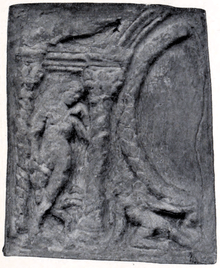Croy Hill
Croy Hill was a Roman fort,[6] fortlet,[7] and probable temporary camp[8] on the Antonine Wall, near Croy, to the north east of the village in Scotland.[9] Two communication platforms known as ‘expansions’ can be seen to the west of the fortlet.[10] Alexander Park excavated the site in 1890-1891.[11] Sir George Macdonald wrote about his excavation of the site which occurred in 1920, 1931,[12] and 1935.[13] At Croy Hill, the ditch in front of the rampart was not excavated by the Romans. It is likely that hard basalt and dolerite of the hill was virtually impossible to shape with Roman tools. This is the only place along the Wall where the ditch wasn't dug.[14] There is a bath house just outside one fort.[15] A video reconstruction of the site has been produced.[16]
| Croy Hill | |
|---|---|
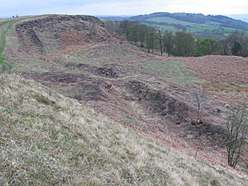 Antonine Wall at Croy Hill | |
| Alternative name(s) | Croy Hill Fort |
| Founded during the reign of | Antoninus Pius |
| Place in the Roman world | |
| Province | Britannia |
| Stationed military units | |
| — Legions — | |
| 6th[1] | |
| Location | |
| County | East Dumbartonshire |
| Country | |
| Site notes | |
| Excavation dates | 1890-1891, 1920, 1931, 1935, 1975-1978 |
| Archaeologists | Alexander Park, George Macdonald, William Hanson |
| Exhibitions | Hunterian Museum |
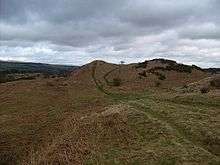
At Croy Hill three religious objects have been found: one, as fragments of a relief of Jupiter Dolichenus;[17][18][19][20] a second, an altar dedicated to Nymphs;[21] and a third, identified as an altar to Mars.[22][23] Other artefacts found include a bronze arm purse,[24][25] a storage jar filled with ashes,[26][27] and a fragment of "face mask" jar.[28][29] These items are now kept in the Hunterian Museum,[30] Glasgow along with others like the altar found at Castlecary. Only four coins have been discovered near the fort and an axe was also found near the hill.[31] A gravestone was discovered; it shows a soldier with other men, perhaps his sons, at his side. It has been scanned and a video produced.[32][33]
.jpg)
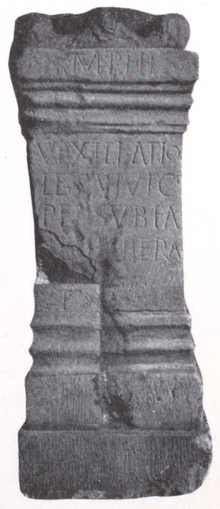

Croy hill's neighbouring forts were Barr Hill to the west and Westerwood to the east. The larger Roman forts of which this was not one had a nominal cohort of 1000 men[35] but probably sheltered women and children as well although the troops were not allowed to marry.[36] There is likely too to have been large communities of civilians around the site.[37]
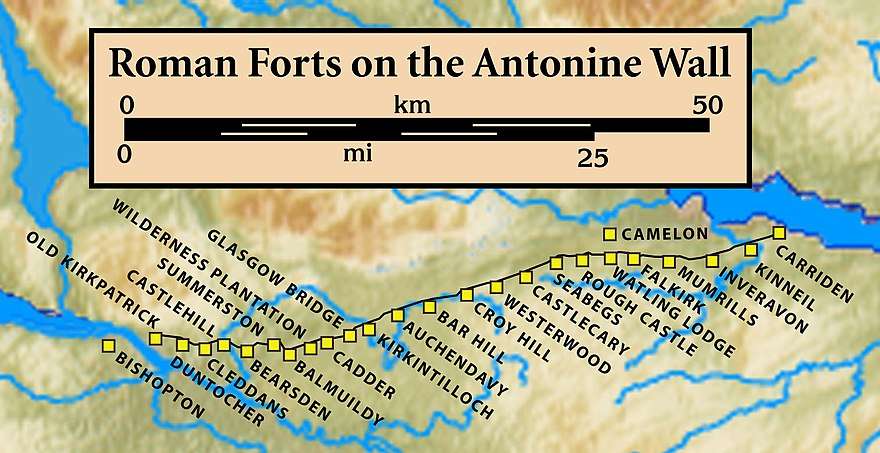
| Wikimedia Commons has media related to Croy Hill. |
References
- "CROY HILL: FORT, FORTLET, WALL, AND TEMPORARY CAMP" (PDF). Frontiers of the Roman Empire. Retrieved 7 May 2018.
- "RIB 2163. Building inscription of the Sixth Legion". Retrieved 5 May 2018.
- "Sculptured stone (piece)". NMS. Retrieved 26 May 2018.
- Macdonald, Sir George (1934). The Roman wall in Scotland, by Sir George Macdonald (2d ed., rev., enl., and in great part rewritten ed.). Oxford: The Clarendon press. pp. 401–402. Retrieved 11 October 2017.
- "XFV44InscribedSlabCroy2". Retrieved 9 November 2018.
- "Antonine Wall, Croy Hill Roman Fort". Canmore. Historic Environment Scotland. Retrieved 14 October 2017.
- "Antonine Wall, Croy Hill Roman Fortlet". Canmore. Historic Environment Scotland. Retrieved 14 October 2017.
- "Antonine Wall: Croy Hill". Historic Environment Scotland. Retrieved 14 October 2017.
- "Places: 89155 (Croy Hill)". Pleiades. Retrieved 13 August 2016.
- "Antonine Wall, Croy Hill Roman Signal Platform (East)". Canmore. Historic Environment Scotland. Retrieved 14 October 2017.
- Rohl, Darrell, Jesse. "More than a Roman Monument: A Place-centred Approach to the Long-term History and Archaeology of the Antonine Wall" (PDF). Durham Theses. Durham University. Available at Durham E-Theses Online ref: 9458. Retrieved 14 October 2017.
- MacDonald, George (1932). "Notes on the Roman Forts at Old Kilpatrick and Croy Hill, and on a Relief of Jupiter Dolichenus". Proceedings of the Society of Antiquaries of Scotland. 66: 219–276. Retrieved 10 November 2018.
- Macdonald, Sir George (1934). The Roman wall in Scotland, by Sir George Macdonald (2d ed., rev., enl., and in great part rewritten ed.). Oxford: The Clarendon press. pp. 258–270. Retrieved 11 October 2017.
- "Castlecary Antonine Wall Fort". Roman Britain. Archived from the original on 5 June 2018. Retrieved 10 October 2017.
- "Croy Hill and the Antonine Wall, near Kilsyth". Walk Highlands. Retrieved 19 October 2017.
- "CroyHill_Comp". Retrieved 5 December 2018.
- Keys, David (27 June 2018). "Ancient Roman 'hand of god' discovered near Hadrian's Wall sheds light on biggest combat operation ever in UK". Independent. Retrieved 6 July 2018.
- Miller, S. N. (1952). The Roman Occupation Of South Western Scotland Being Reports Of Excavations And Surveys Carried Out Under The Auspices Of The Glasgow Archaeological Society By John Clarke, J. M. Davidson, Anne S. Robertson, J. K. St. Joseph, Edited For The Society With An Historical Survey By S. N. Miller. Glasgow: Robert Maclehose & Company Limited. p. 238. Retrieved 11 October 2017.
- "RIB 2158. Dedication to Jupiter Optimus Maximus of Doliche". Roman Inscriptions of Britain. Retrieved 7 July 2018.
- Macdonald, Sir George (1934). The Roman wall in Scotland, by Sir George Macdonald (2d ed., rev., enl., and in great part rewritten ed.). Oxford: The Clarendon press. p. 269. Retrieved 11 October 2017.
- "Croy Hill". Canmore. Historic Environment Scotland. Retrieved 14 October 2017.
- "altar to Mars". Hunterian Museum. University of Glasgow. Archived from the original on 20 October 2017. Retrieved 12 October 2017.
- "Altar (Roman)". Retrieved 14 October 2017.
- "Arm Purse, Croy Hill". Retrieved 21 October 2017.
- "arm purse". Hunterian Museum. University of Glasgow. Archived from the original on 20 October 2017. Retrieved 12 October 2017.
- "Jar and Ashes, Croy Hill". Retrieved 21 October 2017.
- "storage jar filled with ashes". Hunterian Museum. University of Glasgow. Archived from the original on 20 October 2017. Retrieved 12 October 2017.
- "Fragment of face mask jug, Croy Hill". Retrieved 21 October 2017.
- "storage jar filled with ashes". Hunterian Museum. University of Glasgow. Archived from the original on 20 October 2017. Retrieved 12 October 2017.
- "The Antonine Wall: Rome's Final Frontier". The Hunterian. University of Glasgow. Retrieved 10 October 2017.
- "Palstave (Bronze)". Canmore. Historic Environment Scotland. Retrieved 14 October 2017.
- "XFV43GravestoneCroyhill". Retrieved 9 November 2018.
- "Croy Hill". Frontiers of the Roman Empire. Retrieved 14 October 2017.
- "XFV42AltarNymphsCroyHill". Retrieved 9 November 2018.
- Miller, S. N. (1952). The Roman Occupation Of South Western Scotland Being Reports Of Excavations And Surveys Carried Out Under The Auspices Of The Glasgow Archaeological Society By John Clarke, J. M. Davidson, Anne S. Robertson, J. K. St. Joseph, Edited For The Society With An Historical Survey By S. N. Miller. Glasgow: Robert Maclehose & Company Limited. Retrieved 11 October 2017.
- "Roman child's leather shoe". A History of the World. BBC. Retrieved 17 October 2017.
- Rohl, Darrell, Jesse. "More than a Roman Monument: A Place-centred Approach to the Long-term History and Archaeology of the Antonine Wall" (PDF). Durham Theses. Durham University. Available at Durham E-Theses Online ref: 9458. Retrieved 14 October 2017.
